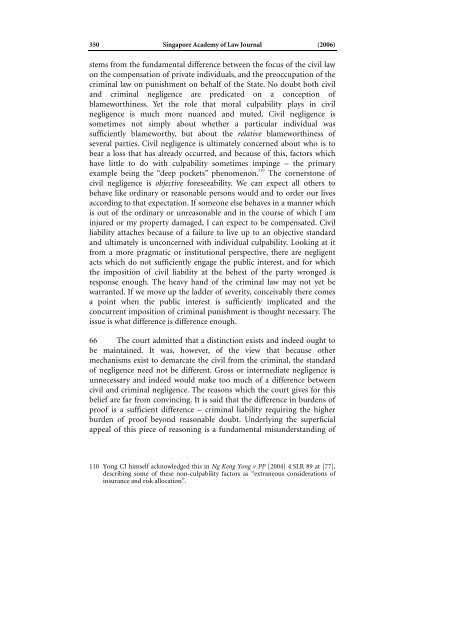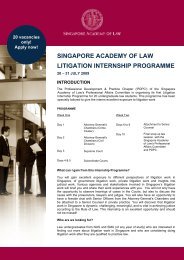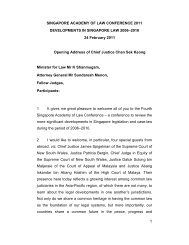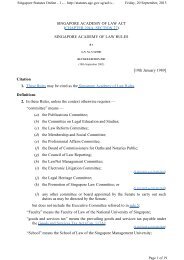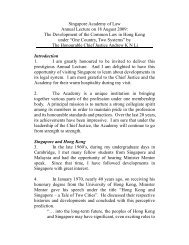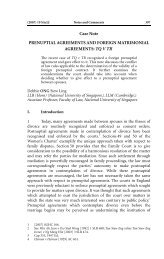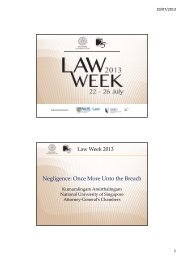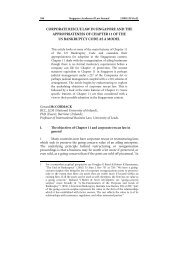2. Managing Mens Rea in Singapore - Singapore Academy of Law
2. Managing Mens Rea in Singapore - Singapore Academy of Law
2. Managing Mens Rea in Singapore - Singapore Academy of Law
Create successful ePaper yourself
Turn your PDF publications into a flip-book with our unique Google optimized e-Paper software.
350S<strong>in</strong>gapore <strong>Academy</strong> <strong>of</strong> <strong>Law</strong> Journal (2006)stems from the fundamental difference between the focus <strong>of</strong> the civil lawon the compensation <strong>of</strong> private <strong>in</strong>dividuals, and the preoccupation <strong>of</strong> thecrim<strong>in</strong>al law on punishment on behalf <strong>of</strong> the State. No doubt both civiland crim<strong>in</strong>al negligence are predicated on a conception <strong>of</strong>blameworth<strong>in</strong>ess. Yet the role that moral culpability plays <strong>in</strong> civilnegligence is much more nuanced and muted. Civil negligence issometimes not simply about whether a particular <strong>in</strong>dividual wassufficiently blameworthy, but about the relative blameworth<strong>in</strong>ess <strong>of</strong>several parties. Civil negligence is ultimately concerned about who is tobear a loss that has already occurred, and because <strong>of</strong> this, factors whichhave little to do with culpability sometimes imp<strong>in</strong>ge – the primaryexample be<strong>in</strong>g the “deep pockets” phenomenon. 110The cornerstone <strong>of</strong>civil negligence is objective foreseeability. We can expect all others tobehave like ord<strong>in</strong>ary or reasonable persons would and to order our livesaccord<strong>in</strong>g to that expectation. If someone else behaves <strong>in</strong> a manner whichis out <strong>of</strong> the ord<strong>in</strong>ary or unreasonable and <strong>in</strong> the course <strong>of</strong> which I am<strong>in</strong>jured or my property damaged, I can expect to be compensated. Civilliability attaches because <strong>of</strong> a failure to live up to an objective standardand ultimately is unconcerned with <strong>in</strong>dividual culpability. Look<strong>in</strong>g at itfrom a more pragmatic or <strong>in</strong>stitutional perspective, there are negligentacts which do not sufficiently engage the public <strong>in</strong>terest, and for whichthe imposition <strong>of</strong> civil liability at the behest <strong>of</strong> the party wronged isresponse enough. The heavy hand <strong>of</strong> the crim<strong>in</strong>al law may not yet bewarranted. If we move up the ladder <strong>of</strong> severity, conceivably there comesa po<strong>in</strong>t when the public <strong>in</strong>terest is sufficiently implicated and theconcurrent imposition <strong>of</strong> crim<strong>in</strong>al punishment is thought necessary. Theissue is what difference is difference enough.66 The court admitted that a dist<strong>in</strong>ction exists and <strong>in</strong>deed ought tobe ma<strong>in</strong>ta<strong>in</strong>ed. It was, however, <strong>of</strong> the view that because othermechanisms exist to demarcate the civil from the crim<strong>in</strong>al, the standard<strong>of</strong> negligence need not be different. Gross or <strong>in</strong>termediate negligence isunnecessary and <strong>in</strong>deed would make too much <strong>of</strong> a difference betweencivil and crim<strong>in</strong>al negligence. The reasons which the court gives for thisbelief are far from conv<strong>in</strong>c<strong>in</strong>g. It is said that the difference <strong>in</strong> burdens <strong>of</strong>pro<strong>of</strong> is a sufficient difference – crim<strong>in</strong>al liability requir<strong>in</strong>g the higherburden <strong>of</strong> pro<strong>of</strong> beyond reasonable doubt. Underly<strong>in</strong>g the superficialappeal <strong>of</strong> this piece <strong>of</strong> reason<strong>in</strong>g is a fundamental misunderstand<strong>in</strong>g <strong>of</strong>110 Yong CJ himself acknowledged this <strong>in</strong> Ng Keng Yong v PP [2004] 4 SLR 89 at [77],describ<strong>in</strong>g some <strong>of</strong> these non-culpability factors as “extraneous considerations <strong>of</strong><strong>in</strong>surance and risk allocation’’.


